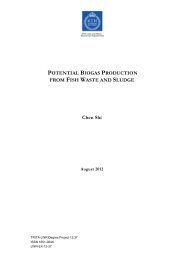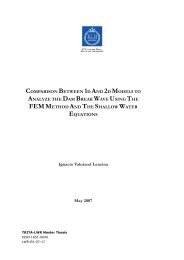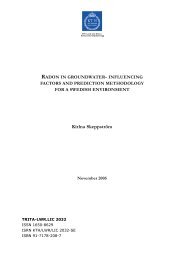water sources, infrastructure, space and the dynamics of ...
water sources, infrastructure, space and the dynamics of ...
water sources, infrastructure, space and the dynamics of ...
You also want an ePaper? Increase the reach of your titles
YUMPU automatically turns print PDFs into web optimized ePapers that Google loves.
Water <strong>sources</strong>, <strong>infrastructure</strong>, <strong>space</strong> <strong>and</strong> <strong>the</strong> <strong>dynamics</strong> <strong>of</strong> environmental diseases in Saboba District: Using GISPressing Environmental Problems in Saboba DistrictTable 9 shows <strong>the</strong> most pressing environmental problems in <strong>the</strong> districtfrom <strong>the</strong> results <strong>of</strong> <strong>the</strong> questionnaire. The most ranked ones (five) arecompared <strong>and</strong> analysed. In general, <strong>the</strong> pressing environmental problemsin Saboba District include free-range defecation, lack <strong>of</strong> clean/treated<strong>water</strong>, bushfires, presence <strong>of</strong> stagnant <strong>water</strong> <strong>and</strong> littered environment.However, what is considered <strong>the</strong> most pressing environmental problemsin each specific area differs. Ranking <strong>the</strong>m in Central Township depictspoor drainage at <strong>the</strong> top; bushfires, free-range defecation, lack <strong>of</strong>clean/treated <strong>water</strong> <strong>and</strong> presence <strong>of</strong> stagnant <strong>water</strong> follows in that order.Free-range defecation, bushfires (same level as 1 st ), lack <strong>of</strong> clean/treated<strong>water</strong>, littered environment (same level as 3 rd ) <strong>and</strong> presence <strong>of</strong> stagnant<strong>water</strong> are <strong>the</strong> environmental problems in Toma, while Chief-section haslack <strong>of</strong> clean <strong>water</strong>, bushfires, free-range defecation, deforestation <strong>and</strong>l<strong>and</strong> degradation. Free-range defecation, presence <strong>of</strong> stagnant <strong>water</strong>,weedy environment <strong>and</strong> littered environment are ranked in Bordagbalm,<strong>and</strong> lack <strong>of</strong> clean/treated <strong>water</strong>, free-range defecation, <strong>water</strong> shortages,poor drainage <strong>and</strong> bushfires in Wapuli. There is no clear differencebetween <strong>the</strong> various environmental problems in each particular place.Gender <strong>and</strong> Environmental Diseases in Saboba DistrictTable 10 shows very high illiteracy rate in <strong>the</strong> district for both men(73.7%) <strong>and</strong> women (81.3%), with a total average <strong>of</strong> 77.5%, which ishigher than <strong>the</strong> regional <strong>and</strong> national averages <strong>of</strong> 72.3% <strong>and</strong> 38%respectively. Also, more males get educated than females due to <strong>the</strong>stereotype roles <strong>of</strong> woman in <strong>the</strong> district as being mainly householdchores <strong>and</strong> child bearing <strong>and</strong> caring. Lower education <strong>of</strong> women <strong>and</strong>o<strong>the</strong>r issues mentioned in <strong>the</strong> conceptual framework may be at work inputting women at risks to <strong>the</strong>se environmental diseases.Figure 6 <strong>and</strong> appendix IIIa depict that women are disproportionatelyaffected by <strong>water</strong> related diseases, as more than half (54.2%) <strong>of</strong> <strong>the</strong>people treated with <strong>water</strong> related diseases in Saboba Medical Centre(SMC) were women compared to 45.8% for men. However, for o<strong>the</strong>rdiseases, a sharp reverse is <strong>the</strong> case as 54.5% were men <strong>and</strong> 45.5% beingwomen. The explanation is that generally, more men have access to <strong>the</strong>defence mechanisms listed in <strong>the</strong> conceptual framework <strong>of</strong> this study(Fig. 2), due to <strong>the</strong>ir control <strong>of</strong> re<strong>sources</strong> <strong>and</strong> power in <strong>the</strong> family.Therefore, women higher percentage (54.2%) <strong>of</strong> <strong>water</strong> related diseasesclearly shows that <strong>the</strong>y are largely affected by <strong>the</strong>se diseases than <strong>the</strong>irmen counterparts. Also, more women (54.5%) than men (45.5%)reported with RTI, owning to <strong>the</strong> fact that more women are exposed toenvironmental hazards (e.g. cooking with firewood) than men. The tablealso shows that 67.3% <strong>of</strong> Genital <strong>and</strong> Sexually Transmitted Infections(STIs) were women <strong>and</strong> only 32.7% being men. This confirms <strong>the</strong> widelyheld view that more women than men are suffering from HIV/AIDS<strong>and</strong> o<strong>the</strong>r STIs (Oppong, 1998 p.1) due to <strong>the</strong>ir vulnerability. A medical<strong>and</strong> psychological research is needed to determine why more womenthan men get hypertension.Data from WHC (Fig. 7 <strong>and</strong> appendix III b), just like in SMC, show thatwomen formed 51.5% <strong>of</strong> cases <strong>of</strong> <strong>water</strong> related diseases such as Malaria<strong>and</strong> Onchocerciasis <strong>and</strong> 48.5% for men. For o<strong>the</strong>r diseases such asHepatitis, Anaemia, Yaws <strong>and</strong> Epilepsy, a sharp contrast occurred with57.9% being men <strong>and</strong> 42.1% women. Again, women (60%) predominatein Genital <strong>and</strong> STIs as against 40.0% men. Also, 52.6% <strong>and</strong> 63.2%women <strong>and</strong> 47.8% <strong>and</strong> 36.8% men reported on RTI <strong>and</strong> Pneumoniarespectively. The analysis shows that <strong>water</strong> related diseases such as23
















